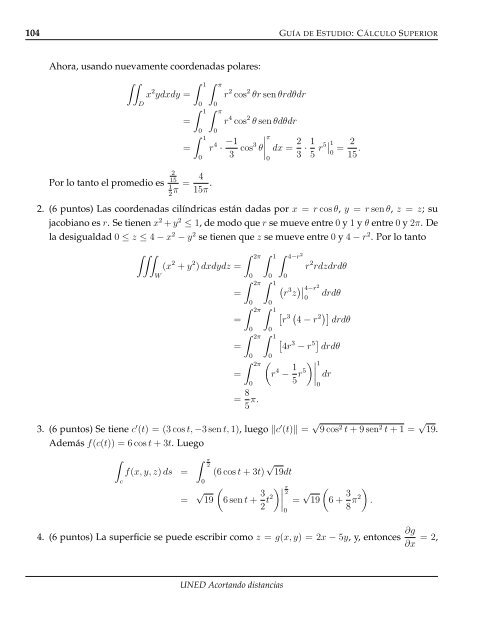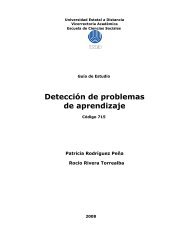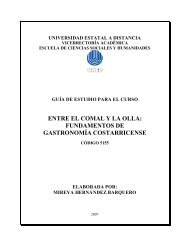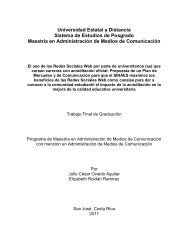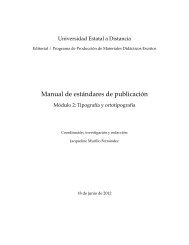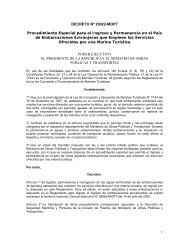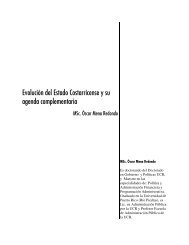GE3011 Cálculo Superior - Repositorio de la Universidad Estatal a ...
GE3011 Cálculo Superior - Repositorio de la Universidad Estatal a ...
GE3011 Cálculo Superior - Repositorio de la Universidad Estatal a ...
You also want an ePaper? Increase the reach of your titles
YUMPU automatically turns print PDFs into web optimized ePapers that Google loves.
104 GUÍA DE ESTUDIO: CÁLCULO SUPERIOR<br />
Ahora, usando nuevamente coor<strong>de</strong>nadas po<strong>la</strong>res:<br />
<br />
Por lo tanto el promedio es<br />
D<br />
x 2 ydxdy =<br />
2<br />
15<br />
1<br />
2<br />
=<br />
=<br />
1<br />
0<br />
1<br />
0<br />
1<br />
0<br />
4<br />
=<br />
π 15π .<br />
π<br />
r<br />
0<br />
2 cos 2 θr sen θrdθdr<br />
π<br />
r<br />
0<br />
4 cos 2 θ sen θdθdr<br />
r 4 · −1<br />
3 cos3 π<br />
<br />
θ<br />
dx = 2 1<br />
·<br />
3 5 r5 1 2<br />
= 0 15 .<br />
2. (6 puntos) Las coor<strong>de</strong>nadas cilíndricas están dadas por x = r cos θ, y = r sen θ, z = z; su<br />
jacobiano es r. Se tienen x 2 + y 2 ≤ 1, <strong>de</strong> modo que r se mueve entre 0 y 1 y θ entre 0 y 2π. De<br />
<strong>la</strong> <strong>de</strong>sigualdad 0 ≤ z ≤ 4 − x 2 − y 2 se tienen que z se mueve entre 0 y 4 − r 2 . Por lo tanto<br />
<br />
W<br />
(x 2 + y 2 ) dxdydz =<br />
=<br />
=<br />
=<br />
=<br />
0<br />
2π 1 4−r2 0 0 0<br />
2π 1 <br />
3 4−r<br />
r z 2<br />
0 0<br />
2π 1<br />
0 0<br />
2π 1<br />
0<br />
2π<br />
0<br />
= 8<br />
5 π.<br />
0<br />
r 2 rdzdrdθ<br />
0<br />
drdθ<br />
r 3 4 − r 2 drdθ<br />
4r 3 − r 5 drdθ<br />
<br />
r 4 − 1<br />
5 r5<br />
1 <br />
3. (6 puntos) Se tiene c ′ (t) = (3 cos t, −3 sen t, 1), luego c ′ (t) = √ 9 cos 2 t + 9 sen 2 t + 1 = √ 19.<br />
A<strong>de</strong>más f(c(t)) = 6 cos t + 3t. Luego<br />
<br />
c<br />
f(x, y, z) ds =<br />
π<br />
2<br />
0<br />
= √ 19<br />
(6 cos t + 3t) √ 19dt<br />
<br />
6 sen t + 3<br />
2 t2<br />
π<br />
2<br />
0<br />
0<br />
dr<br />
= √ <br />
19 6 + 3<br />
8 π2<br />
<br />
.<br />
4. (6 puntos) La superficie se pue<strong>de</strong> escribir como z = g(x, y) = 2x − 5y, y, entonces ∂g<br />
∂x<br />
UNED Acortando distancias<br />
= 2,


